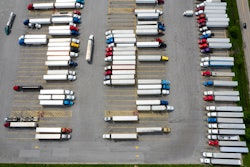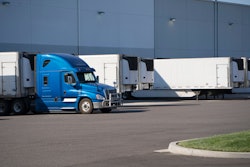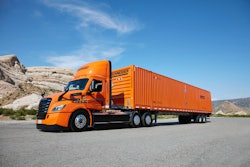A report released earlier this year by trucking tech firm Motive found that, while safety is a priority for fleets, it’s not the top priority in a lot of cases. In Motive’s State of Safety Report, 95% of responding fleet managers said driver safety performance was a priority, but when asked to rank priorities, they ranked “increasing revenue” and “minimizing expenses” ahead of “improving safety.”
There are ways for fleets to prioritize safety while also boosting revenue and minimizing expenses, however.
Joining Jason and Matt this week on the 10-44 is Jon Bernstein, vice president of product management for mobile workforce tech firm Motus, who explains that prioritizing safety will also have positive impacts on revenue and expenses.
Contents of this video
00:00 Prioritizing driver safety performance
04:09 Costs to employers for motor vehicle crashes
05:40 Safety programs from a cost avoidance perspective
07:17 Returns for money spent on safety
08:09 Online safety training programs for drivers
Jason Cannon:
This week's 10-44 is brought to you by Chevron Delo 600 ADF ultra low ash diesel engine oil. It's time to kick some ash.
Matt Cole:
While almost all fleets recognize safety as a priority, it's not always the top priority.
Jason Cannon:
You're watching CCJ's 10-44, a weekly episode that brings you the latest trucking industry news and updates from the editors of CCJ. Don't forget to subscribe and hit the bell for notifications so you'll never miss an installment of 10-44.
Hey everybody, welcome back. As always, I am still Jason Cannon and right through there, as always, is Matt Cole.
A report released earlier this year by trucking tech firm, Motive, found that while safety is a priority for fleets, it's not the priority in a lot of cases. In Motive's State of Safety report, 95% of responding fleet managers said that driver safety performance was a priority, but when asked to rank priorities, they ranked increasing revenue and minimizing expenses ahead of improving safety.
Matt Cole:
There are ways for fleets to prioritize safety while also boosting revenue and minimizing expenses, however. Jon Bernstein, VP of Product Management for mobile workforce tech firm, Motus, explains that while the company's primary work is with mileage tracking for fleets of cars and vans, the company's safety offerings are applicable across driving industries.
Jon Bernstein:
Motus is a company that helps organizations with their mobile workforce operate and perform as most efficiently as possible. Our core business is really around vehicle reimbursement, so basically the ability for individuals or employees of those organizations that drive considerable business miles a year, let's say more than 5,000 based on IRS regulations, a way in which that they can properly and efficiently reimburse those employees for the personal use of their vehicles. So in the Class 7 and Class 8 vehicle space, obviously those are commercial-sized vehicles, so for the most part, our direct work in terms of what I just described is more for less than Class 7, Class 8 vehicle types, and again, driving personal vehicles or assets for those types of driver communities.
But certainly, as you look at mixed fleets and fleets just in general that have various driving populations in way in which they deploy their employees and the assets in which they drive, whether they be personal or business owned, we can blend, particularly in the topic we'll talk about today, our safety offering to really go across all of their driver bases and classifications in terms of the offering we provide.
Jason Cannon:
Now while Jon says that there's a lot of obvious direct costs associated with crashes, there's also indirect costs that could be avoided with a proper safety program in place. We'll hear exactly what those are after a word from 10-44 sponsor, Chevron Lubricants.
Protecting your diesel engine and its after-treatment system has traditionally been a double-edged sword. The same engine oil that is so essential to protecting your engine's internal parts is also responsible for 90% of the ash that is clogging up your DPF and upping your fuel and maintenance costs. Outdated industry thinking still sees a trade-off between engine and emission system protection, and Chevron was tired of it, so they spent a decade of R&D developing a no-compromise formulation.
Chevron Lubricants developed a new ultra low ash diesel engine oil that is specifically designed to combat DPF ash clogging. Delo 600 ADF with omnimax technology cuts sulfate ash by a whopping 60%, which reduces the rate of DPF clogging and extends DPF service life by two and a half times. And just think what you can do with all the MPGs you're going to add from cutting your number of regens. But Delo 680 ADF isn't just about after treatment. It provides complete protection, extending drain intervals by preventing oil breakdown. Before, you had to choose between protecting your engine or your after-treatment system, and now you don't. 600 ADF from Delo with omnimax technology. It's time to kick some ash.
Jon Bernstein:
First and foremost, I think the direct and indirect cost to employers from motor vehicle crashes are wide-ranging and substantial. The direct costs are all around worker comp benefits, healthcare costs, increase in medical insurance premiums. The list goes on and on, the things that you directly are being charged for and you can see, but you think about some of those indirect costs, as well, supervisor time in terms of rescheduling or special arrangements, the time to coordinate vehicle repair, replacement, reassignment of personnel to cover for missing employees. It all blends together in such a way where employers are really paying for the crashes that both happen on and off the job. And implementing a comprehensive safety program is really a profitable investment from a time and resource perspective.
The other thing that I'd add is the sheer dollars. I think the last study that I had seen from the National Highway Transportation Safety Board is it's over $70 billion in terms of the cost to employers. And it's interesting because you got to remember that even in off-the-job crash, that, again, has implications like we were just describing in terms of the direct and indirect costs that affects the employers. So really making sure that organizations are thinking holistically and what it means to them is, I think, incredibly important.
Matt Cole:
Everybody in the trucking industry wants to be safe and have safe drivers and trucks. Sometimes, though, as long as things are going well for a fleet, safety gets put on the back burner until something happens.
Jon Bernstein:
Miles are dollars and obviously with hours of service and other regulations, it's obviously top of mind. I think safety in general is one of those things where until you get hit with it, it's almost like a set it and forget it or think about it and then it goes to the back of your brain. But when you start to pile on, again, some of the statistics that we were just describing and talking about, obviously they become extremely material in terms of just the potential cost avoidance that putting a safety program in place would obviously afford an organization. So I think until it hits the organization, it just becomes like a set it and forget it or think about it but don't put it to the top of the list type of scenario again.
Getting from point A to point B, delivering on service commitments, those are the things that are revenue drivers. These are really cost avoidance measures, and so until there's a lawsuit or something like that, it tends to be more of a "let me do what's minimally required of us in order to make sure that we're," I hate to say it but, "checking the box." But I think with a comprehensive training program, the opportunity from a cost avoidance perspective is obviously extremely significant.
Jason Cannon:
Money spent on safety does provide a positive return on investment, Jon says, but that return tends to go unnoticed.
Jon Bernstein:
Just a quick statistic. So on average, what we've seen is, is for every dollar spent on safety, the return is anywhere from three to call it $5, whether it be personally-owned vehicles or fleet vehicles. So there's material return, but again, it goes sometimes in that visible versus invisible scenario because until it really happens, it's hard to ultimately quantify as opposed to, "I made one more delivery today," or, "I was able to go see one more client and I was able to sell this deal." And you see, obviously, the impact of what that has provided from a top-line perspective.
Matt Cole:
Jon says it's never been easier to get training programs in front of drivers with online programs that can be sent to phones or other in-cab devices.
Jon Bernstein:
Our training product is web-based. Nowadays, all of these are web-based offerings. The simplicity of deploying training modules all can be done directly on a mobile device, in an in-cab device if it was a Class 8 or Class 8 over-the-road trucking vehicle. Obviously, simple things like doing not only annual MVR, or motor vehicle record, checks, but having continuous monitoring of those records I think are critically important. I think it's all about getting ahead of the game and being visible and focused on the puts and takes that can really drive potential either bad driving behavior or bad outcomes to the driver and then, therefore, the employer, are critical. So again, it's really around motor vehicle record checks, monitoring and verifying insurance coverage levels, putting training programs in place that don't have to necessarily be classroom-oriented like they may have been in the past, but rather being web-based. They could be short two or three minute snippets that before starting out on your first appointment, load it up, review it. I think the reinforcement piece of like riding a bike, the more you do it, the more it becomes ingrained is key and critical for these organizations.
Jason Cannon:
That's it for this week's 10-44. You can read more on ccjdigital.com. While you're there, sign up for our newsletter and stay up to date on the latest in trucking industry news and trends. If you have any questions or feedback, please let us know in the comments below. Don't forget to subscribe and hit the bell for notifications so you can catch us again next week.











